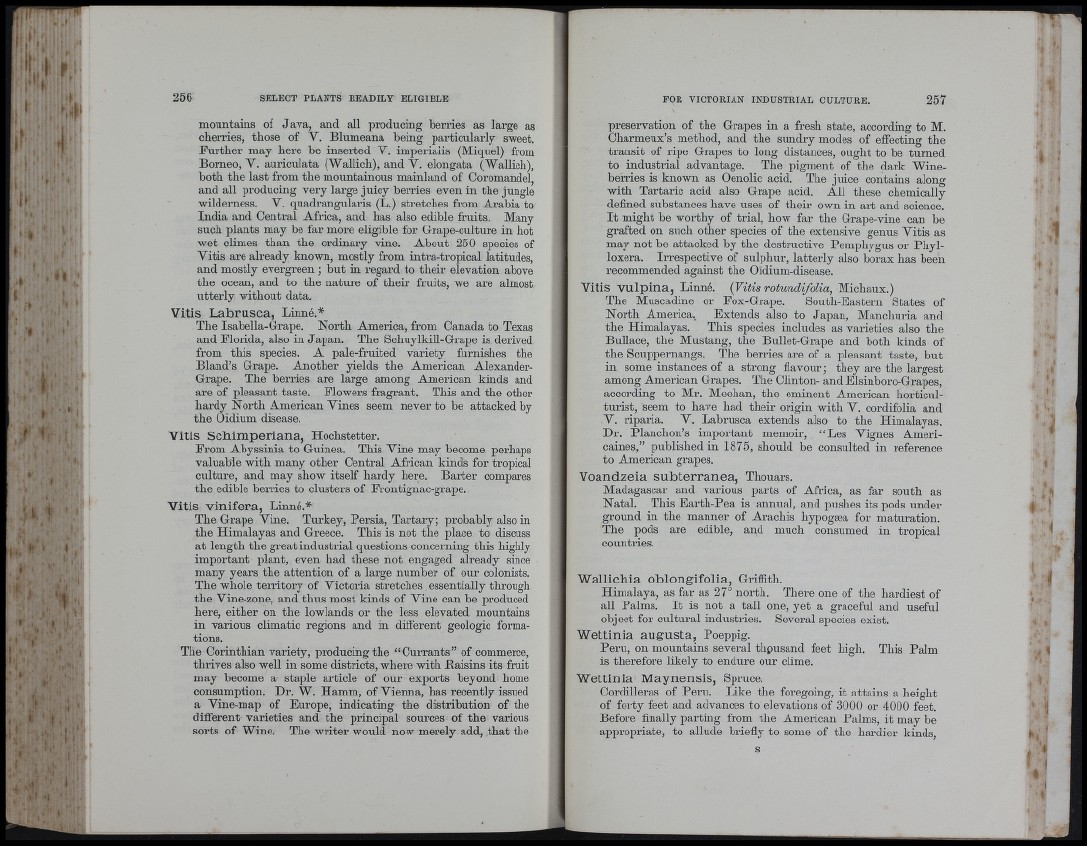
f
( i
t t
mountains of Java, and all producing berries as large as
cherries, those of Y. Blumeana being particularly sweet.
Enrther may here he inserted Y. imperiaiis (Miquel) from
Borneo, V. auriculata (Wallich), and V. elongata (Wallicli),
both the last from the mountainous mainland of Coromandel,
and all producing very large juicy berries even in the jungle
wilderness. V. quadrangularis (L.) stretches from Arabia to
India and Central Africa, and has also edible fruits. Many
such plants may be far more eligible for Crape-culture in hot
wet climes than the ordinary vine. About 250 species of
Vitis are already known, mostly from intra-tropical latitudes,
and mostly evergreen ; but in regard to their elevation above
the ocean, and to the nature of their fruits, we are almost
utterly without data.
Vitis Labrusca, Linné.*
The Isahella-Grape. North America, from Canada to Texas
and Florida, also in Japan. The Schnylkill-Grape is derived
from this species. A pale-fruited variety furnishes tie
Bland’s Grape. Another yields the American Alexander-
Grape. The berries are large among American kinds and
are of pleasant taste. Elowers fragrant. This and the other
hardy North American Vines seem never to be attacked by
the Oidium disease.
Yitis Schimperiana, Hochstetter.
From Abyssinia to Guinea. This Vine may become perhaps
valuable with many other Central African kinds for tropical
culture, and may show itself hardy here. Barter compares
the edible berries to clusters of Frontignac-grape.
Yitis vinifera, Linné.*
The Grape Yine. Turkey, Persia, Tartary; probably also in
the Himalayas and Greece. This is not the place to discuss
at length the great industrial questions concerning this highly
important plant, even had these not engaged already since
many years the attention of a large number of our colonists.
The whole territory of Victoria stretches essentially through
the Vine-zone, and thus most kinds of Vine can be produced
here, either on the lowlands or the less elevated mountains
in various climatic regions and in different geologic formations.
The Corinthian variety, producing the “ Currants” of commerce,
thrives also well in some districts, where with Baisins its fruit
may become a staple article of our exports beyond home
consumption. Dr. W. Hamm, of Vienna, has recently issued
a Vine-map of Europe, indicating the distribution of the
different varieties and the principal sources of the various
sorts of Wine. The writer would now merely add, that the
preservation of the Grapes in a fresh state, according to M.
Charmeux’s method, and the sundry modes of effecting the
transit of ripe Grapes to long distances, ought to be turned
to industrial advantage. The pigment of the dark Wine-
berries is known as Oenolic acid. The juice contains along
with Tartaric acid also Grape acid. All these chemically
defined substances have uses of their own in art and science.
I t might be worthy of trial, how far the Grape-vine can be
grafted on such other species of the extensive genus Vitis as
may not be attacked by the destructive Pemphygus or Phylloxera.
Irrespective of sulphur, latterly also borax has been
recommended against the Oïdium-disease.
Yitis vulpina, Linné. (Vitis rotundifolia, Michaux.)
The Muscadine or Eox-Grape. South-Eastern States of
North America.^ Extends also to Japan, Manchuria and
the Himalayas. This species includes as varieties also the
Bullace, the Mustang, the Bnllet-Grape and both kinds of
the Scuppernangs. The berries are of a pleasant taste, but
in some instances of a strong flavour; they are the largest
among American Grapes. The Clinton- and Elsinboro-Grapes,
according to Mr. Meehan, the eminent American horticulturist,
seem to have had their origin with V. cordifolia and
V. riparia. V. Labrusca extends also to the Himalayas,
Dr. Planchon’s important memoir, “ Les Vignes Américaines,”
published in 1875, should be consulted in reference
to American grapes.
Yoandzeia subterránea, Thouars.
Madagascar and various parts of Africa, as far south as
Natal, This Earth-Pea is annual, and pushes its pods under
ground in the manner of Arachis hypogæa for maturation.
The pods are edible, and much consumed in tropical
countries.
Wallichia oblongifolia, Griffith.
Himalaya, as far as 27° north. There one of the hardiest of
all Palms. I t is not a tall one, yet a graceful and useful
object for cultural industries. Several species exist.
Wettinia augusta, Poeppig.
Peru, on mountains several thpusand feet high. This Palm
is therefore likely to endure our clime.
Wettinia Maynensis, Spruce.
Cordilleras of Peru. Like the foregoing, it attains a height
of forty feet and advances to elevations of 3000 or 4000 feet.
Before finally parting from the American Palms, it may be
appropriate, to allude briefly to some of the hardier kinds,
S
I '